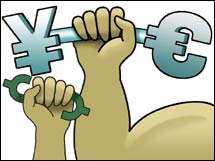The dollar's slide: How far, how hard?The currency sank about 2.5 percent against the euro in the last 5 sessions. More losses may be coming.(Fortune Magazine) -- U.S. currency traders gorged on Thanksgiving turkey and took a half day last Friday while the rest of the world quietly bet against the dollar. At first, it looked like a handful of speculators were taking advantage of light trading volume, which makes it easier to move a market up or down. But then more players started lining up against the greenback, too, and the worries hit harder than post-holiday indigestion.
The dollar has tumbled about 2.5 percent against the euro in the five sessions through Tuesday. Although the greenback came back a bit Wednesday, the dollar's near its weakest against the euro since March 2005. The dollar also fared badly against the British pound, though it's done slightly better against the lowly Japanese yen. "With the dollar debacle, the health of the economy, current and future, is on trial," said Brian Wesbury, chief economist at First Trust Advisors. And he, like many other traders and strategists, sees a weaker dollar in the months to come thanks to a combination of slower economic growth, the possibility of interest rate cuts from the Federal Reserve and long-term trends in international currency markets. Currencies typically have a six- to seven-year cycle of adjustments, said Quincy Krosby, chief investment strategist at Hartford Financial. "If you look at February 2002 as the strongest point in the cycle, I do think [the dollar] will ease a bit more. But that's also just part of the adjustment process that began [almost seven years ago] and is continuing." Many observers have been bearish on the dollar since the start of 2006, when the so-called yield curve in the Treasury bond market kept inverting, meaning that investors got a better return on the short-term, two-year government bond than on the long-term, 10-year Treasury note. That's the opposite of how yields usually behave - and an inverted curve preceded the nation's last two recessions. But back at the start of the year, most economists said it looked unlikely the United States was headed for a recession this time - that the economy would not stumble on a housing slump, rising interest rates in Europe or a series of rate hikes by the Federal Reserve. Now, some fear that those comforting predictions may not hold true. Foreign banks, for example, may be deciding that the United States is getting too risky because the U.S. economy doesn't look as attractive with sluggish growth ahead, said Naomi Fink, director of foreign exchange strategy at BNP Paribas. "It reminds me of the time surrounding the tech boom when many equity analysts were saying that P/E ratios were irrelevant," said Fink, referring to the relationship of stock prices to corporate earnings. "Similarly, we shouldn't have discounted arguments for a slowdown in the U.S. Prior to this recent move, currency traders were ignoring bad data, or only looking at the good elements of the bad data." The bad data includes the housing slump, said money manager Hugh Moore, a partner at Guerite Advisors, who's forecasting a recession sometime in 2007. "The jobless recovery happened after 2001 because of home equity," said Moore. "Wages stagnated, but people didn't want to give up their lifestyles." So instead, they borrowed against the value of their homes. He estimated that home equity withdrawals in 2004 and 2005 totaled about $1.4 trillion, and that two-thirds of that fueled consumer spending. Consumer spending in turn fuels more than two-thirds of economic growth, so its importance can't be underestimated. Moreover, Wesbury said that more rate hikes from the Fed remain a possibility, or at least the central bank won't cut rates anytime soon. Wall Street has been anticipating a cut for months, hoping that the Fed would lower the benchmark rate to keep the economy from slowing too much. But Fed Chairman Ben Bernanke said in a speech Tuesday that while growth should pick up next year, inflation remains a "worrisome" threat, which could mean that the Fed's next move on rates is a rate hike, and not a cut. Much of the recent betting against the dollar has been on the expectation that a weak U.S. economy would force the Fed to cut rates. Lower rates make the dollar less attractive relative to other currencies. Meanwhile, Wednesday's upward revision to third-quarter economic growth indicates that economy is growing modestly, while a key inflation gauge dipped. That should ease short-term concerns about a recession, but, as Krosby points out, there was no pop for the troubled greenback. "The GDP numbers were upwardly revised, but there was immediately no significant strengthening in the dollar. If the market instinctively believed the economy was chugging along well, there at least would have been a knee jerk reaction." Perhaps the dollar's muted rebound against the euro Wednesday can be traced to the news that new home sales fell a larger-than-expected 3.2 percent in October, quelling hopes that the worst of the real estate slump was over. "What we really should focus on is that fact that the Americans were on holiday and foreigners decided to sell," said Axel Merk, manager of the Merk Hard Currency Fund, which has $47 million under management, referring to the dollar's recent drop. "Given the extent to which we're dependent on foreigners to prop up the dollar because of our current account deficit, that's worrisome." "A dollar decline is in nobody's interest, but it's highly overdue and will happen at some point," Merk said. Economy grew faster than first thought |
|

